Lea Wait's Blog, page 37
June 10, 2024
Karen Read Murder Trial: The Twists and Turns
My writing has been put on hold lately on account of the court trial that is going on in Massachusetts. This case has caught my attention for the last two years. As I write this, the trial is in its sixth week and I can’t get enough of it of it. By far, it is the craziest I’ve ever seen. Even many of the court observers and bloggers are saying this.

The trial pits the Commonwealth of Massachusetts versus Karen Read. It is a complex, convoluted and highly irregular case that defies easy explanation, but I will do my best to explain it in all its lunacy.
Karen Read worked in high finance and was a professor at Bentley University. She was dating Boston police officer, John Okeefe. They went out to a bar and met some other people at a bar in Canton. One of the people at the bar was legendary (and infamous) Boston police officer, Bryan Albert, and his family. Also there was Brian Higgins, an ATF agent. Everyone went back to Bryan Albert’s house for an after party. Karen Read did not want to go, but John did. She dropped him off at the house just as a nor’easter snow storm started to come down. Then she waited a few minutes. John O’keefe’s lifeless body was found on Bryan Albert’s lawn the next morning. He was officially pronounced dead at the hospital around 7:30 am.
To understand the town of Canton, you must know the tight connections that exist between the citizens there. Everyone knows everyone and has their back. Bryan Albert’s brother is still a cop in town. His brother a town councilor. The police chief and Brian Higgins were close friends, to the pint where Higgins had an office in the Canton P.D. The lead detective on the case was state trooper Michael Proctor, who was good friends with the family, but denied it until finally admitting g it under oath. Complicating matters, Karen Read was discovered to have been flirting over the phone with Brian Higgins. Nothing happened between them, but it appears that she was getting payback against John because he flirted with a girl on a trip to Aruba.
The Commonwealth claims that Karen Read backed into John that night after they engaged in a fight. They claim she drove 24 miles per hour in reverse, up a winding hill, in a snowstorm, and rammed into John. Only John’s injuries are inconsistent with those of getting hit by a car. He has two black-and-blue eyes. Cuts on his nose. And a deep gash on the back of his head. Also, and more interesting, he has a series of scratches on his arms that look like claw marks and dog bites.

Come to find out that the Albert’s owned a German Shepherd named Chloe. Despite their initial statements that the dog was not violent, the defense tracked down public records that revealed that Chloe had attacked two people and put them in the hospital. After the murder, The Albert’s not only rehomed Chloe, but they replaced their basement floor and then sold their house at a loss, and this during Covid when houses in suburban Boston were selling at a premium.
Before John Okeefe’s body was found at 6:30 a.m., Jennifer McCabe, a family member inside the house that night, Googled “Hos long to die in the cold” at 2:30 in the morning. Although she denied making this Google search, the call was discovered on Cellebrite, the most widely used Phone extraction tool, and used by state and fed prosecutors all over the country. Not only did she make this search, but then she deleted it afterward, which are all recorded on the Cellebrite records. Then she deleted all of the calls she made between 12:30 am until 6:30 the next morning. All of these called were extracted using Cellebrite. All of these calls she denied making, including two to her sister that were answered.

Bryan Albert called Bryan Higgins around 2:20 that morning. The call was answered. Then Higgins called Albert. The call was answered. Yet in their testimony both men deny making these calls, claiming they butt dialed each other. Jennifer McCabe called John Okeefe’s phone seven times around 12:30 and deleted them all. But these were discovered on John Okeefe’s phone, proving that she lied. It appears that the people inside the house were trying to locate John’s phone AFTER he was attacked inside the Albert home.
Here are some other interesting facts about the case.
-John was missing a sneaker the morning his body was found and the initial searches didn’t find it.
-John’s Apple data said he got out of the car and walked up a flight of stairs; the exact distance it would have taken for him to go up and into the Albert home.
-Apart from the scratches and bites on his arm, John, who was six-foot-two, had no injuries to his body below the neck, which would be consistent with getting hit by a car.
-The lead investigator, state trooper Michael Proctor, was close friends with the Albert’s and McCabes.
-Proctor seized Karen’s phone before getting a subpoena and illegally searched through it looking for nude photos of her. He called his friends on his private phone and told them this. He called her vulgar names and said he hoped she would kill herself. Then, in a cryptic way, he told his friends that Albert would never be accused of this crime.
-No taillight was found by the Canton police who responded to the crime scene, and this before much snow fell. Even the State police SERT team found nothing hours later. Yet the Proctor claimed to have found 46 pieces of twilight in the following days, WITHOUT any documentation. So didn’t the Canton police chief, who was not only on medical leave, but was good friends with Higgins.
-None of the police searched the Albert house for signs of a crime or considered it a crime scene.
-The members of the family were interviewed together instead of being interviewed separately. And they were interviewed in their own home, and not on video.
-The day before Bryan Albert and Brian Higgins were to receive an order to preserve their phones as evidence, they destroyed their phones and SIM cards, and got new phones and new phone numbers.
-The chain of custody for the clothes and other evidence was broken and never properly logged.
-The town of Canton’s snowplow driver, Lucky Laughran, unequivocally claims not to have seen a body on the Albert lawn the first time he plowed that morning. Later that morning, when he plowed again, he claims to have seen a Ford Edge parked exactly where John’s body was found. Three members of the family own a Ford Edge. Was John’s body planted there?
-Across the street from the Albert’s lived another Canton police officer. He claimed there was nothing on his ring camera. That ring camera was aimed directly where John’s body was found. The police never asked any of the neighbors for their ring cam video.
-Two minutes of the Canton library’s video was missing. It was the exact time Karen’s vehicle would have driven past, revealing no broken taillight, which would have proven that the police broke her taillight later in the morning in order to frame her.
-Currently, the state police is investigating trooper, Michael Proctor. His investigation of the Karen Read case was so weak that he prosecution has yet to call him to the stand to testify. It’s rumored he might take the 5th when the defense calls him.
-The FBI is investigating the DA, the Canton police, and the State police. In addition, the Feds provided the defense with three thousand pages of evidence relevant to the case. The investigation is ongoing throughout this trial and arrests might come after the verdict.
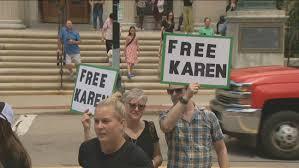
These are just a few of the problems in this messy case. In my opinion, Karen Read is innocent. The defense is using a Third Party Culprit defense, meaning they are trying to prove that someone other than Karen Read killed John. They don’t have to definitively prove who did it. They are allowed to create enough doubt that no jury would believe beyond a reasonable doubt that Karen killed her boyfriend.
Watch the trial yourself and see where you stand. I’m sure it will be turned into a Hollywood movie someday. The case has deeply divided people on the Internet and in the town of Canton. I believe Karen is an innocent woman. What do you think?
One thing is for certain. If you decide to commit a crime, make sure and leave your phone at home.

June 7, 2024
Weekend Update: June 8-9, 2024
 Next week at Maine Crime Writers there will be posts by Joe Souza (Monday), Jule Selbo (Tuesday), Vaughn Hardacker (Thursday) and Rob Kelley (Friday).
Next week at Maine Crime Writers there will be posts by Joe Souza (Monday), Jule Selbo (Tuesday), Vaughn Hardacker (Thursday) and Rob Kelley (Friday).
In the news department, here’s what’s happening with some of us who blog regularly at Maine Crime Writers:
On Thursday, June 13th, Dick Cass, Kate Flora, and alum Barbara Ross will be at the Scarborough Library. Here’s the info:


If you haven’t registered yet, there’s still time to attend next weekend’s Maine Crime Wave. Here’s the info: https://www.mainewriters.org/maine-crime-wave
An invitation to readers of this blog: Do you have news relating to Maine, Crime, or Writing? We’d love to hear from you. Just comment below to share.
And a reminder: If your library, school, or organization is looking for a speaker, we are often available to talk about the writing process, research, where we get our ideas, and other mysteries of the business, along with the very popular “Making a Mystery” with audience participation, and “Casting Call: How We Staff Our Mysteries.” We also do programs on Zoom. Contact Kate Flora
And Suddenly…..Nothing

You go to your favorite restaurant anticipating the joy of eating your favorite meal, their seafood platter. When you try to order it, the serving person tells you that you can’t. You must order something else. “Are you out of seafood?” you ask.
“No, we have plenty of seafood,” the person replies.
“If you have plenty of seafood, why can’t I order a seafood platter?”
“That is a good question,” the server replies. “The problem is that we are out of platters.”
This illustrates a looming crisis in the Maine library community. As things stand now, interlibrary loan, something many Maine residents use frequently, will cease on July first. That’s the platter in this scenario. (actually, it has already ceased, but I wrote much of this last weekend)
At first, there was little reaction, outrage, or discussion about this looming storm, but that has changed, particularly since the issue hit the press and TV two days ago. if you ask staff members in libraries privately, many are steaming over the issue. It comes about because the contract to renew the van delivery that sorts and transports books, movies, music, and more between libraries came up for renewal and things got messy. (In hindsight, much of the anger and frustration could have been mitigated if the problem had been discussed earlier)
That service transports approximately 8,000 items a day among Maine libraries. The van service allows smaller libraries like Stratton, Rangeley, and Belgrade to borrow not only items they can’t afford to purchase, but request multiple copies for book groups. It’s a huge resource for homeschooling families, and a service I use several times a week. I am copying my colleague Josh Tiffany’s perspective on the problem from his May report for the Gray Public Library. Our daughter Lisa is one of their patrons and was the person who originally alerted me to the looming disaster. He and his staff have been very proactive in making their patrons aware of this issue. That’s something EVERY library on the van service should be doing now. Can you imagine this not happening and you being a circulation staff member on July first. The thought of how much surprised outrage they might face makes me shudder.
Here are Josh’s thoughts on the issue:
5) Van delivery
a. On Saturday, May 4th, it was announced that the van delivery would be
experiencing some upcoming issues. The first was that the Maine State Library
for years has funded one free day of van delivery for any library in Maine that
meets certain (and very low) criteria. And second, there would be a gap in van
delivery due to circumstances outside of Maine State Library’s control.
i. The contract for the current courier service was ending on June 30, 2024.
The RFP for the new courier was not posted until March 27, 2024, with a
due date of late April. If there were no complications to the process, there
would be no delay in service.
ii. There were three bidders for the RFP, one of which failed to meet
minimum criteria. While both bids were vastly increased over previous
years (which follows a trend that many years in coming), the winning bid
was 25% higher than the bid from the current van delivery courier. This
increase was the driving force behind Maine withdrawing the free day to
all libraries. It was initially said that a sliding scale would be deployed so
it would be fair to everyone.
1. Later communications arrived (after I emailed several parties
requesting clarifying information on many points) that Maine would be remaining with the free day of van delivery for FY25 due
to the inability of many libraries to pivot their budget with no
notices. The new plan will be implemented in FY26.
iii. Due to the Procurement Office in Maine State government requesting
input from technology experts, this delayed the process by 30-days –
which was the first reason given for the upcoming gap in service.
iv. One of the bidders filed a request for appeal of the RFP award. On May
16th, it was stated that the appeal had been granted which put a pause on
the entire transition from one service to the next. Since the appeals must
be heard within a 60-day window, and then considered and ruled on, the
delays could run for four to five months.
v. If the appeal is upheld, the RFP process starts over from the beginning,
meaning no van delivery service for multiple months.
vi. Based on another question I asked, it was stated that if the costs of van
delivery increase to the point that numerous libraires have to adjust their
delivery days (currently, Gray has one day paid for Maine State Library,
one day paid for by Minerva ((which has guaranteed that it will not change
membership rates based on increased van delivery costs this year and will
use its surplus to bridge the gap; in future years, the cost will go up)), and
two days that we pay for out of our regular budget. With everything
paused, we will not know the expense of this service until well into the
budget season.
vii. Maine State Library is strongly encouraging libraries to NOT use personal
vehicles for the transport of library items – something that occurred the
last time Maine State Library hired a new courier, and it went south in a
matter of days.
viii. Due to the inability to provide any kind of timeline for resumption of
services, several voices on list-servs (mine included) advocated for
shutting down inter-library requesting immediately so that when July 1
occurred, there would be a limited number of materials trapped in limbo.
The response from Maine State Library is that all activity needs to
maintain as they currently are. Any deviation would be perceived as
violating the Stay order issued by the Procurement Office.
ix. In June, we will be contacted with the cost of continuing service. At this
point, we may change our delivery options.
x. Apart from telling us when they will have updates, the only promise from
Maine State Library is that it will communicate ideas for how libraries of
all sizes can address this gap in service, particular around messaging to
patrons.
xi. For more information, please visit: https://maine-msl.libguides.com/c.php?g=1393867
NOTE: I wrote this last weekend, but it finally got some press and TV traction yesterday. My cynical mind grabbed the following from it:
According to a post on the Maine State Library website, STAT Courier was chosen as the winning bidder in part because it provides the same type of service in 16 other states and its trucks, drivers and sorters only deal with library materials. It has three sorting hubs in Maine that will help with efficiency and has a 24/7 customer service line, according to the state library.
I looked st the company website. They handle more than just library delivery. If the MSL statement is accurate, what are their three sorting facilities currently sorting? This might be sour grapes on my part, but as a former employee of the Maine State Library, my cynicism has some reality base. Your thoughts?
June 5, 2024
Ireland, Again

Sunlight on the sea, County Kerry, Ireland.
Last month I wrote about how happy we were to connect with my Fenton cousins who still make their home on the farm in County Kerry where my grandmother was raised, and how intrigued we were during a visit to the rural townland in County Mayo from which my grandfather Kane emigrated.
A link to that post is here: https://mainecrimewriters.com/2024/05/06/finding-family-in-ireland/

Of course we found the National Library , , ,
My grandparents were with us in spirit for the rest of our trip, especially in Dublin, where we made a point to visit EPIC – The Irish Emigration Museum. That’s right—Ireland lost so much of its population in the 19th and early 20th centuries that it has a museum dedicated to those who left.
An exemplar of effective multi-media storytelling, EPIC is an immersive experience about the practical and emotional aspects of the Irish diaspora.
We absorbed stories, gazed at photos, listened to music and came away with a deeper appreciation of why my grandparents and so many other Irish people in the 19th and 20th centuries responded to the siren call of America and other far-off places, yet held their homeland close in their hearts until they died.

14 Henrietta Street is a powerful social history museum in Dublin.
We also toured 14 Henrietta Street, an elegant Georgian home built in the late 1740s for one of Dublin’s most wealthy and powerful families. A century later, the Henrietta Street neighborhood had become one of Dublin’s poorest, and by the early 1900s, #14 had been transformed into a tenement where more than 100 people lived cheek-by-jowl.
Condemned in the 1970s, the building was purchased by the city in 2000 and has now been transformed into a social history museum that effectively tells the story of its (and Dublin’s) sometimes painful past.
On a different sort of inspirational front, we were wowed by MoLI, the Museum of Literature Ireland. Ireland has gifted the world with many brilliant writers, and MoLI honors them all.

Mr. Joyce, himself.
An entire room is (appropriately) given over to James Joyce but MoLI also celebrates the work of Samuel Becket, W.B. Yeats, Maeve Brennan, Edna O’Brien, Seamus Heaney, Mary Lavin and many more.

An excerpt from a letter James Joyce sent to a friend about the challenges of getting published. The more things change, the more they stay the same, eh?
A particularly fun interactive exhibit homed in on a truth that’s universal and fundamental—the need to simply start writing, no matter how intimidating the goal of completing a story, a poem, or a novel may feel before your pen scratches paper.

The room where this appears on the wall is papered with cards on which museum-goers are invited to write the first words of their current or dreamed-of project.

Me writing my first line at MoLI
No trip to Ireland is complete without spending some time in local pubs, truly the social hub of most Irish communities.
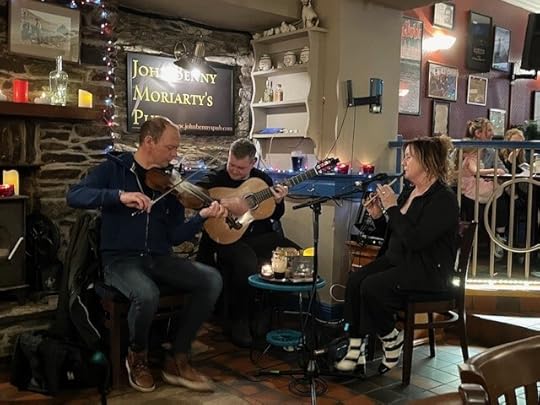
John Benny Moriarty’s in Dingle
For us, traditional music is the draw, and we found plenty at pubs in Dingle, Doolin, Clifden, Galway and Dublin.
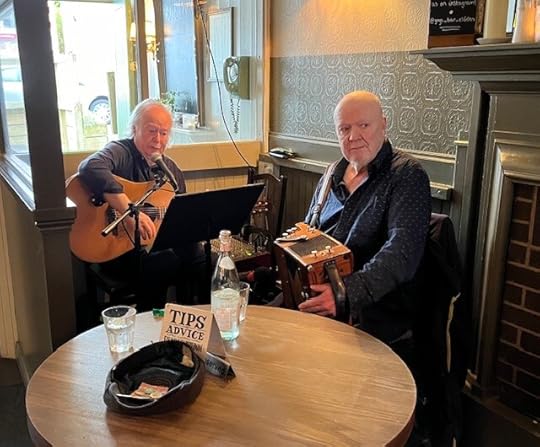
These gentlemen in Clifden both accept tips and give advice.
We missed a Sunday afternoon session at the famous Crane Bar in Galway.
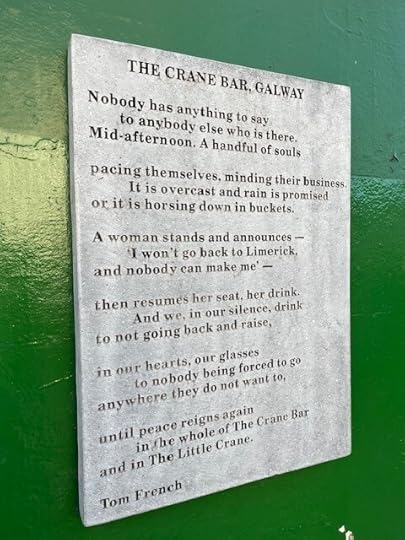 But caught one the next evening at Tig Cóili.
But caught one the next evening at Tig Cóili.
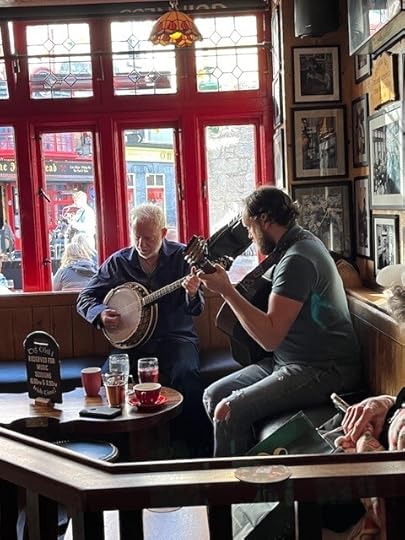
An especially lively session on a Monday evening at Tig Cóili in Galway.
In a wonderful bit of serendipity, we met up with a Maine friend in Dublin.

Our friend Simone is in the middle, wearing a peach colored shirt.
Our pal Simone Daranyi, a talented fiddler born and raised on Peaks Island, has just completed her second year at Trinity College.
Lucky for us, she balances her engineering studies with her love for trad music, and she’s made the grade at the legendary Cobblestone, where the bartenders wear t-shirts proclaiming it to be “A Beer Bar With a Music Problem.”
On our last night in Dublin, it was a special joy to watch and listen to Simone and a group of other traditional musicians play a lively session. If we hadn’t already decided that we must return to Ireland as soon as possible, that night alone would have convinced us.
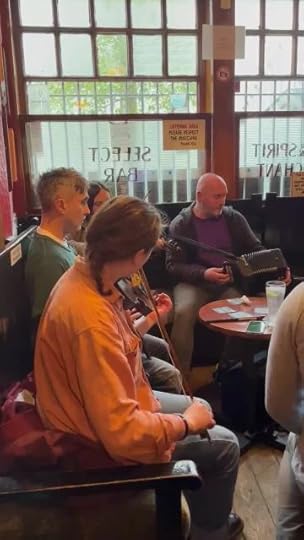
Brenda Buchanan brings years of experience as a journalist and a lawyer to her crime fiction. She has published three books featuring Joe Gale, a newspaper reporter who covers the crime and courts beat. She is now hard at work on new projects. FMI, go to http://brendabuchananwrites.com
When is it time to say goodbye?
Kate Flora: How does a writer know when to say goodbye to a series? It’s a question I’ve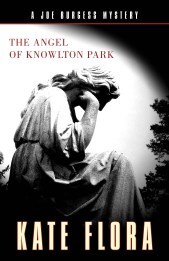 been pondering on a lot lately. When I read a recent Michael Connelly, Harry Bosch was being treated for a serious cancer. He’s a Vietnam vet, so likely in his 70’s. How long can he go on being the tough guy? And then last week, there was an article in the Maine papers saying that Gerry Boyle, a writer I’ve been a long time fan of, is about to publish his last Jack McMorrow mystery. And Barbara Ross is ending her clambake series.
been pondering on a lot lately. When I read a recent Michael Connelly, Harry Bosch was being treated for a serious cancer. He’s a Vietnam vet, so likely in his 70’s. How long can he go on being the tough guy? And then last week, there was an article in the Maine papers saying that Gerry Boyle, a writer I’ve been a long time fan of, is about to publish his last Jack McMorrow mystery. And Barbara Ross is ending her clambake series.
These are interesting questions for me. When I started the Joe Burgess police procedural series, I had planned to write a quartet, with each of the four books taking place in a different season. Playing God takes place in February, beginning on a bitterly cold night in Portland. By contrast, the second Burgess, The Angel of Knowlton Park, begins on a miserably hot summer day. Redemption begins on a beautiful October day and And Grant You Peace, supposed to be the final book in the series, takes place in the spring. I was happy with the plan but a few months after I finished the fourth book, I found that I was missing my characters.
Readers evidently were missing them, too, because I started getting messages asking when the next Burgess would come out. Readers assured me that Maine has lots of other seasons: mud season, hunting season, black fly season, tourist season, etc. Now that I’m working on book nine, I’ve abandoned seasons. Now I try not to have my murders too close together so I can give my characters a break from the action. After the horrific events in A Child Shall Lead Them, Burgess, Kyle, and Perry badly needed a break.
 Like many authors with a first book, I didn’t plan to write a series featuring my Thea Kozak character. I had a story, inspired by an Ann Landers column, about a girl who goes searching for her birth parents and ends up dead. In order to tell that story, I needed someone with a strong enough connection to the victim to be willing to risk danger to find her killer, and Thea appeared in Chosen for Death. It was only when a beta reader said how much he liked the character and would like to see more of her that the series began.
Like many authors with a first book, I didn’t plan to write a series featuring my Thea Kozak character. I had a story, inspired by an Ann Landers column, about a girl who goes searching for her birth parents and ends up dead. In order to tell that story, I needed someone with a strong enough connection to the victim to be willing to risk danger to find her killer, and Thea appeared in Chosen for Death. It was only when a beta reader said how much he liked the character and would like to see more of her that the series began.
That series almost ended at book six, Liberty or Death, when my publisher dropped the series. This may be why many series that seem so promising abruptly end, leaving readers (and writers, of course) disappointed. I was lucky. Jim Huang of the Mystery Company liked Thea, and rescued the series. Now that Thea is married and has finally had the baby she and Andre have longed for, I’ve been thinking it should be a good stopping point. But readers are writing and asking for the next book, so probably, when this Burgess is finished, I’ll see how she can get back into trouble once her maternity leave is over. But here’s the thing: it is as hard to find childcare in a book as it is in real life, so if the series is to go on, Thea’s going to have to find a good nanny.
 I do often wonder how other writers approach the issue of ending a series. Do they run out of ideas for the next plot? Do they get tired of their characters or find themselves repeating plots? Are they tired of writing mystery fiction and long to write something new and different? I have certainly found that taking a break from a series helps to bring me back to it refreshed. At first, it was just the experience of moving from a first person amateur female PI in my Thea Kozak series, to a third person trio of cops in the Burgess series. The series were different enough that I would return to each one eager to see what my characters were up to and to hear their voices.
I do often wonder how other writers approach the issue of ending a series. Do they run out of ideas for the next plot? Do they get tired of their characters or find themselves repeating plots? Are they tired of writing mystery fiction and long to write something new and different? I have certainly found that taking a break from a series helps to bring me back to it refreshed. At first, it was just the experience of moving from a first person amateur female PI in my Thea Kozak series, to a third person trio of cops in the Burgess series. The series were different enough that I would return to each one eager to see what my characters were up to and to hear their voices.
Now that interval often involves writing an entirely different book. True crime? Domestic suspense? Romantic suspense or straight romance? I always come back to one of my series, though. I’m not tired of my characters. I’m still curious about where their stories will go next.
 I’m not even ready to kill off any of my major characters. Readers used to encourage me to kill off Thea’s mother. I thought, and still think, it’s better for her to learn to live with her mother, difficult as she is. And I know how readers feel when characters they love are killed off. Some years ago, a number of series mystery writers were killing off their protagonist’s significant others. I got plenty of mail from readers stating that if I killed off Andre, they wouldn’t read me anymore.
I’m not even ready to kill off any of my major characters. Readers used to encourage me to kill off Thea’s mother. I thought, and still think, it’s better for her to learn to live with her mother, difficult as she is. And I know how readers feel when characters they love are killed off. Some years ago, a number of series mystery writers were killing off their protagonist’s significant others. I got plenty of mail from readers stating that if I killed off Andre, they wouldn’t read me anymore.
So what about you, dear readers? How do you feel when a beloved character or series ends?
June 4, 2024
Sorry. Sleeping. Real post tomorrow
Kate Flora: Dear readers . . . just off a plane from Hawaii and too jet lagged to think or type, so today’s post about letting series protagonists die and series end will actually appear tomorrow.
Meanwhile…here’s where I’ve been. Palm trees, feral chickens, resilient flowers among the lava, and of course silly tropical drinks.

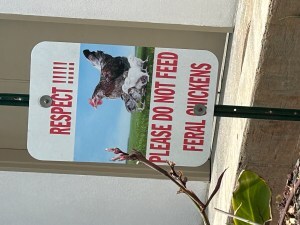






June 2, 2024
Why Getting It Right Should Matter
 Kathy Lynn Emerson here, fired up to tackle an old pet peeve of mine—writers (and editors and reviewers) who don’t seem to care about using forms of address correctly. Just because a book is fiction doesn’t mean it’s okay to play fast and loose with getting the details right. The only exception I can think of would be in the fantasy genre. Otherwise, if an author’s book includes characters with titles, especially British titles, that author had darned well better take five minutes to learn the rules.
Kathy Lynn Emerson here, fired up to tackle an old pet peeve of mine—writers (and editors and reviewers) who don’t seem to care about using forms of address correctly. Just because a book is fiction doesn’t mean it’s okay to play fast and loose with getting the details right. The only exception I can think of would be in the fantasy genre. Otherwise, if an author’s book includes characters with titles, especially British titles, that author had darned well better take five minutes to learn the rules.
I was reminded of this issue while editing the third and fourth Face Down mysteries for new trade paperback editions. A real royal lady appears briefly in both books. The sister of Queen Jane (“the nine-days queen”) she’s not called Lady Mary or Lady Grey. As Queen Elizabeth’s cousin and heiress presumptive, she’s properly referred to as The Lady Mary. And although my sleuth’s husband, who has been knighted, is Sir Robert, his wife is Lady Appleton, not Lady Susanna. Using Lady before a first name indicates that person is the daughter of a peer, which Susanna is not. It was a source of great frustration to me that a blurb on the back cover of the original edition of the first book in the series referred to her as Lady Susanna. The person who wrote the blurb got it wrong and the editor refused to alter a quote. The error was repeated in a review quoted above the title on front cover of the third entry, despite the correct form appearing just below the title. Can you say arrrgh!
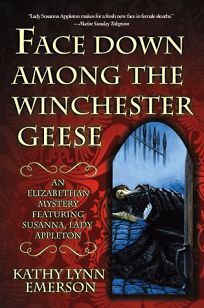
The forms of address problem raised its ugly head again some years ago when I was asked to blurb an historical novel in which a character deliberately chose to be addressed by one of her lesser titles. I really liked the book, but that stopped me in my tracks. I felt obliged, since the novel was still in production, to point out to the editor that the author’s choice was not only odd but also contradictory, since the character was portrayed as egotistical and prideful. He passed on my comment, and author basically told me to mind my own business.
As it turns out, there are occasions when someone might choose not to use a title. The Duchess of Kent, for example, apparently styled herself as “Mrs. Kent” when she taught music, but for the historical period of the novel in question, such a choice would have been unlikely. Moreover, it would have been a simple matter for the author to make the necessary changes to get it right.
No one cared, least of all the editor.

publication date July 11
I see so many novels (and newspaper headlines) that get forms of address wrong that, periodically, I check to make sure I’m not the one who’s mistaken. I’m not. Other writers and their copy editors simply didn’t bother to get the details right. In one otherwise fascinating historical novel, set in the late sixteenth century, the author consistently referred to a knight as Sir Lastname instead of Sir Firstname. That error jerked me out of the story every single time. More recently, I read a mystery in which Dame Agatha Christie was referred to as Dame Christie. To illustrate with a more modern example, Dame Judi Dench or Dame Judi is correct. Dame Dench is not.
 It isn’t just U. S. authors who get things wrong, either. British tabloids are major offenders, which may explain why people are so confused about titles. Referring to the wife of the heir to the throne as Kate Middleton, her maiden name, may make it easy to identify her, but it’s wrong. So is referring to her as Princess Catherine. She is a princess only by virtue of her marriage to the Prince of Wales, so she’s “Princess William.” Her official title is “The Duchess of Cambridge.”
It isn’t just U. S. authors who get things wrong, either. British tabloids are major offenders, which may explain why people are so confused about titles. Referring to the wife of the heir to the throne as Kate Middleton, her maiden name, may make it easy to identify her, but it’s wrong. So is referring to her as Princess Catherine. She is a princess only by virtue of her marriage to the Prince of Wales, so she’s “Princess William.” Her official title is “The Duchess of Cambridge.”
Yes, writing about members of the peerage may require a little research, but it’s not that difficult to get the details right, and forms of address for knights and their ladies isn’t complicated at all. Researching the proper weapons for your characters to use takes far more time and effort.
Not important, you say? Well, consider this—when a reader is stopped dead by an avoidable error, she or he may well react by never reading that author again. It’s even possible that the book in question will be hurled against the wall. Do you want to risk it?

Kathy Lynn Emerson/Kaitlyn Dunnett has had sixty-four books traditionally published and has self published others. She won the Agatha Award and was an Anthony and Macavity finalist for best mystery nonfiction of 2008 for How to Write Killer Historical Mysteries and was an Agatha Award finalist in 2015 in the best mystery short story category. In 2023 she won the Lea Wait Award for “excellence and achievement” from the Maine Writers and Publishers Alliance. She was the Malice Domestic Guest of Honor in 2014. She is currently working on creating new omnibus e-book editions of her backlist titles. Her website is www.KathyLynnEmerson.com.
May 31, 2024
Weekend Update: June 1-2, 2024
 Next week at Maine Crime Writers there will be posts by Kaitlyn Dunnett/Kathy Lynn Emerson (Monday), Kate Flora (Tuesday), Brenda Buchanan (Thursday) and John Clark (Friday).
Next week at Maine Crime Writers there will be posts by Kaitlyn Dunnett/Kathy Lynn Emerson (Monday), Kate Flora (Tuesday), Brenda Buchanan (Thursday) and John Clark (Friday).
In the news department, here’s what’s happening with some of us who blog regularly at Maine Crime Writers:
Kathy Lynn Emerson’s newly edited trade paperback edition of the third Face Down Mystery, Face Down Among the Winchester Geese, will be released on Thursday, June 6. In this one, set in 1563, Lady Appleton suspects her husband is the one who has been killing prostitutes (known as “Winchester Geese”). He’s certainly guilty of something, but his crime may be even worse than murder. Any bookstore or library can order a copy (ISBN 979-8-223-88799-7). Best bet to buy online (to be sure you don’t pay more than the $15.99 price) is through Barnes and Noble https://www.barnesandnoble.com/w/face-down-among-the-winchester-geese-kathy-lynn-emerson/1100069345?ean=9798223887997
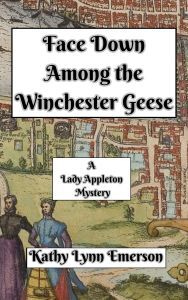
An invitation to readers of this blog: Do you have news relating to Maine, Crime, or Writing? We’d love to hear from you. Just comment below to share.
And a reminder: If your library, school, or organization is looking for a speaker, we are often available to talk about the writing process, research, where we get our ideas, and other mysteries of the business, along with the very popular “Making a Mystery” with audience participation, and “Casting Call: How We Staff Our Mysteries.” We also do programs on Zoom. Contact Kate Flora
May 28, 2024
And now, a Public Service Announcement by Kait Carson
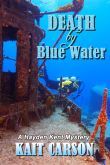 There won’t be too many photos with this one, but it’s a trending topic. Crime writers are happy to see the phrase “ripped from the headlines” in their reviews. If research is to be believed, fiction authors qualify for the same kudos. Not for their awards or best seller status. No, this is not a discussion of rarified air. Rather, there has been recent buzz about the effect reading fiction has on mental health and cognitive stability.
There won’t be too many photos with this one, but it’s a trending topic. Crime writers are happy to see the phrase “ripped from the headlines” in their reviews. If research is to be believed, fiction authors qualify for the same kudos. Not for their awards or best seller status. No, this is not a discussion of rarified air. Rather, there has been recent buzz about the effect reading fiction has on mental health and cognitive stability.
As for the ripped from the headlines part, this is a presidential election year. Both of the leading candidates are…how to say this…experienced…senior…oh, heck, let’s be blunt–have a lot of miles on them. Phrases like competency, the contents of various cognition tests, and stories about dementia, the good, the bad, and the ugly fill news feeds. This is not a political post. Maine has the distinction of having the oldest population of the fifty states. In 2020, forty-five percent of us were over the age of sixty-five. It’s fair to say if there’s a way to stave off the less positive side of our collective ‘experience’, we’re interested.
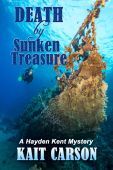 There’s not much we can do about our age other than celebrate and be grateful for it. As the poster reads: It is what it is, it becomes what you make it. Turns out, though, there is at least one easy thing you can do to help keep your mind sharp, and that’s where fiction authors need to take a bow. A March 6, 2020, article in the Harvard Business Review proposed that reading fiction provides greater benefits to the reader than non-fiction. Non-fiction is great for gathering information, but readers of fiction demonstrated greater empathy, social acuity, and ability to understand motivation. All necessary characteristics for socially involved people. And social involvement has long been touted as a key to maintaining good cognitive health.
There’s not much we can do about our age other than celebrate and be grateful for it. As the poster reads: It is what it is, it becomes what you make it. Turns out, though, there is at least one easy thing you can do to help keep your mind sharp, and that’s where fiction authors need to take a bow. A March 6, 2020, article in the Harvard Business Review proposed that reading fiction provides greater benefits to the reader than non-fiction. Non-fiction is great for gathering information, but readers of fiction demonstrated greater empathy, social acuity, and ability to understand motivation. All necessary characteristics for socially involved people. And social involvement has long been touted as a key to maintaining good cognitive health.
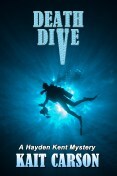 According to a July 6, 2022, New York Times article reading can be an indicator of cognitive health. The article notes that a switch in preferences from fiction to non-fiction can be an early indication of cognitive decline. Fiction requires the reader to have active engagement with the story and the ability to follow characters and storyline from page one to the end. Non-fiction makes fewer demands on reader involvement. Inc. expounded on the Times story in their May 1, 2023 article. They took the benefits of fiction reading one step further by proposing that reading fiction helped prevent memory loss and cited to the benefits of reading crime fiction to keep memory sharp.
According to a July 6, 2022, New York Times article reading can be an indicator of cognitive health. The article notes that a switch in preferences from fiction to non-fiction can be an early indication of cognitive decline. Fiction requires the reader to have active engagement with the story and the ability to follow characters and storyline from page one to the end. Non-fiction makes fewer demands on reader involvement. Inc. expounded on the Times story in their May 1, 2023 article. They took the benefits of fiction reading one step further by proposing that reading fiction helped prevent memory loss and cited to the benefits of reading crime fiction to keep memory sharp.
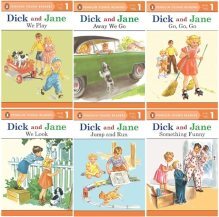 What does all this mean in real life? There is no magic bullet, and memory loss has many causes. If reading, especially reading crime fiction, is shown to strengthen and/or maintain cognitive function, then who are we to argue. Settle in with a good book, follow the clues, find the villain, then thank the author by leaving a review. Your first grade reading teacher was right. Reading is a skill that will enrich your life. It’s only now becoming apparent how very valuable that skill is over a lifetime.
What does all this mean in real life? There is no magic bullet, and memory loss has many causes. If reading, especially reading crime fiction, is shown to strengthen and/or maintain cognitive function, then who are we to argue. Settle in with a good book, follow the clues, find the villain, then thank the author by leaving a review. Your first grade reading teacher was right. Reading is a skill that will enrich your life. It’s only now becoming apparent how very valuable that skill is over a lifetime.
Happy reading.
May 27, 2024
Welcoming A New Cat Into Our Home
Charlene D’Avanzo:
A month or so ago my husband John and I said our last goodbye to Rudy – our feline friend of over thirty years and very good buddy. Rudy was ill with kidney failure and deteriorating very quickly when we carried him to our vet and held him as he passed on. We buried him in the back yard. Guarding the grave are his “friends” – statues of a baby and mama deer.
Our home is now graced with a new kitty we found at Midcoast Humane,
a very impressive animal shelter in Brunswick. All cats and dogs adopted from the
facility are spayed or neutered, microchipped, and have received rabies and distemper vaccinations, flea, tick and de-worming treatments and other care as needed. I certainly recommend the place.
We named our kitty Harvey after a female character in my mysteries. Her nickname is Squeaky because, well, she kind of squeaks. Squeaky promptly claimed her favorite posts in the house – the big soft chair outside our bedroom and the tall stool in the bathroom where she watches birds at our feeder.
I’m amazed how quickly this cat settled into her new home. There’s a 3-3-3- rule for new cats – three days to decompress, three weeks to learn your routine, and three months to start feeling at home. Maybe I’m reading her wrong, but Squeaky sure acts like she’s pretty comfortable.
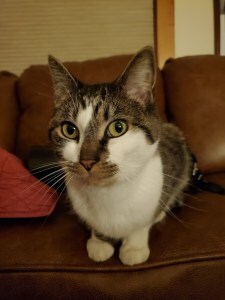
Lea Wait's Blog
- Lea Wait's profile
- 509 followers



